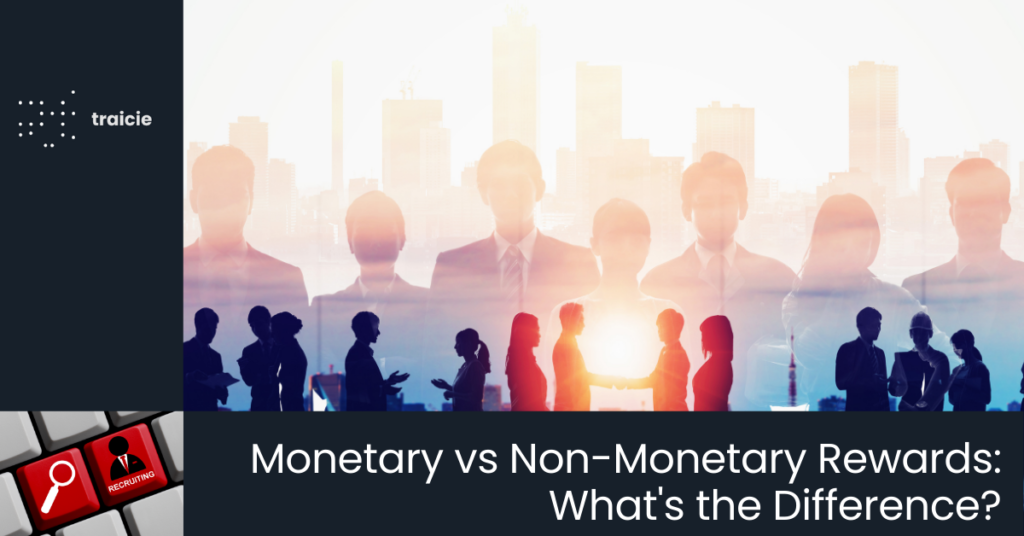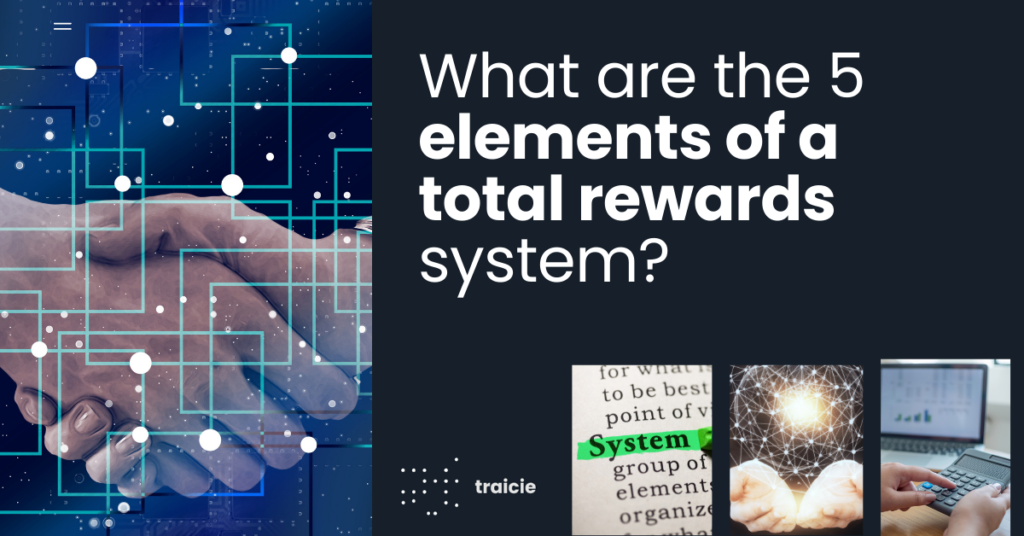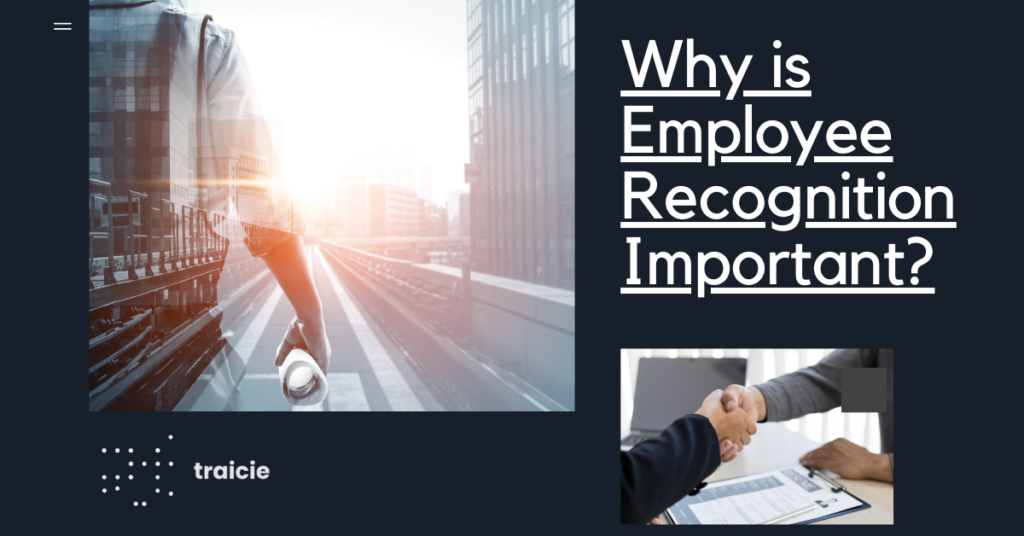In recent years, to refer to compensation and benefits, HR professionals used the term “C&B” quite often. However, now, the term “Total Rewards” is more generally used instead. The reason for that is that companies nowadays offer multiple extra incentives to their employees, not limited to only compensation (pay raise) and benefits.
What are Total Rewards?
Total reward denifition:
Specifically, Total rewards are the combination of benefits, compensation, and rewards that employees receive from their organizations. This can include wages and bonuses, recognition, workplace flexibility, and career opportunities.
The primary reason people go to work is usually to make ends meet, to pay the bills. Therefore, the salary should meet employees’ basic needs and provide financial support.
Given that human beings are not all the same, we are different entities living different lives and having various needs; money can solve some people’s problems, but not all. That explains why companies not only offer monetary incentives to their workers but also non-monetary support, including healthcare, mental care, family care, and career development. With this multi-support, employees can be at ease to work, make a positive contribution, serve customers, and retain a long-term relationship with the company.
In this article, traicie would like to show you more about “Total Rewards”: 5 different components of “Total Rewards” following the latest HRCI standard. Furthermore, we will explore several “Total Reward” strategies that American companies follow.
For example
Every year, big news agencies in the USA will release a report named; “Top best places to work” for that year, according to employees. In the report, the most critical characteristics that employees value in their companies are:
- Salary and other welfare schemes,
- Work environment,
- Corporate culture,
- Career advancement opportunities.
Specifically, Big corporations like Amazon, Apple, and Google offer huge compensations & benefits (or Total Rewards) that attract a great number of job seekers to apply for jobs at these companies. It creates fierce competition among candidates, given that the chance for a person to get a job in these big corporations is more diminutive than being accepted into Harvard University.
| >>> Find out: the solution of AI in HR: How it eliminate hiring bias? benefits, limitations.
Although your company may not have as much financial strength to offer outrageous salaries and bonuses as other big multinational companies, you still should design and implements effective “Total Reward” strategies. With the right “Total Rewards” strategy, your company can attract and retain new talents and be an ideal place to work that your employees will appreciate.
What are the different models of total rewards?
There are two main types of rewards in terms of cash values, which are monetary and non-monetary rewards. Monetary vs. Non-Monetary Rewards: What’s the Difference? What are the 5 elements of a total rewards system?
Do you know that traicie can help you to reduce Total Reward Deal per Candidate Effectively?
What is the Monetary rewards?
In brief, Compensation with an objective cash value, such as salary, revenue, achievement, year-end bonus, perks, benefits, paid leave, and funding for education.
What are the Non-monetary rewards?
Anything that benefits the employee, such as insurance, healthcare programs, time-off, flexible working, well-being support, recognition, and professional development. Though these benefits may not have any monetary value, they are essential to the employees.
Shortly, Grouping monetary and non-monetary rewards constitute 5 pillars of a comprehensive reward system. It includes compensation, benefits, work-life balance (wellness), performance recognition, and career development.

What is Compensation Meaning?
Regarding compensation, the terms ‘wage’ and ‘salary’ are generally used interchangeably to describe an employer’s payment to his employees for their work. Specifically, There are several differences between a salary and a wage.
Wage vs Salary
Wage is the compensation paid to an employee based on the number of hours the employee has worked. Paid workers are manual workers such as assembly line workers, shop assistants, bartenders, housekeeping staff, and babysitters.
| >>> You might also wonder: What is the difference between salary and wage?
Most waged employees are non-exempt. Hence they are eligible to receive overtime pay if their working hours exceed 40 hours per week, according to US labour law.
How to calculate wage?
Gross wage = the number of hours worked * the wage rate per hour
Employers usually pay the employees’ paychecks each week or every two weeks.
The current federal minimum wage for covered nonexempt employees is $7.25 per hour. It indicates that whatever job the worker takes, he or she must be paid at least $7.25 per hour.
This number may vary in states and cases. In some states such as California, New York, and Washington D.C, the minimum wage can be $14-15 per hour.
Salary
Salary is a set amount of money your employer will pay you yearly. Moreover, It is based on various factors, including your job characteristics, experience, academic background, job location, and the type of organization.
Furthermore, salary does not depend on how many hours you have worked. If you are a salaried person working more than 40 hours per week, you will not receive any overtime payment.
Professional people with high academic backgrounds and technical expertise are usually paid a salary. For instance, office workers such as accountants, software developers, project managers, marketing staff, HR staff and many others often receive salaries on an annual basis.
Average annual salary
In fact, According to the latest data from the U.S. Bureau of Labor Statistics (BLS), the annual mean wage for a full-time wage or salary worker in the United States in 2022 is $53,490 per year.
Check out the average annual salary of several popular jobs in the USA (2022):

While offering compensation to employees, companies also pay the employees more if their performance is outstanding. Let’s say exceeding the sales target, making a positive contribution to the company’s development. Incentives or bonuses are extra payments on top of their salaries. Particularly, There are some slight differences between incentives and bonuses.
Incentive vs bonus
Bonus is a backward-looking payment. It is not pre-determined and is decided after accomplishing goals as a surprise without any previous communication.
On the contrary, an incentive is a forward-looking, guaranteed payment associated with a specific plan and objectives. It is focused on performance, encouraging the employees to try their best to achieve particular goals.
An example of a bonus can be:
At the end of the year, the company’s total revenue increased 3 times higher than last year, which is beyond the board of directors expectations. Later, the board of directors decided that each employee was rewarded $5000 each and a small portion of the company’s stock. Chiefly, This compensation is not planned previously, and thus, it is called a bonus.
An example of an incentive can be:
For example, The manager informs the employees that this quarter if the team successfully finalizes 5 current projects, each team member will be rewarded $2000 each and a trip to Singapore. The aim is to give employees a clear idea of the benefits. Hence the members are motivated to complete these projects successfully on time. This compensation is declared to them before their task achievements. It also guarantees to the employees if they accomplish the task. In brief, it is called an incentive.
Quiz?
Company A tells the employees that if productivity increases twice more than last year, at the end of this year, each worker will be rewarded $3000. So, Is it an incentive or a bonus?
Incentive. Since this “extra pay” is informed to the employees before they have started working on the task. Hence It is a forward-looking, guaranteed payment focused on performance to encourage employees to give their best to achieve the goal.
- Benefits
Benefits may vary depending on the Labour laws of each country. In the USA, the Government obliged every company to offer its employees several benefits:
| Obliged Benefits | Other attractive benefits |
| Social security Health insurance Unemployment insurance Workers compensation insurance Disability insurance |
Dental Insurance Retirement plans Vacation packages Unlimited paid time-off |
What is unlimited paid time-off?
Unlimited paid time off means no limits on paid annual leave, and employees can take as many days off when needed as long as doing so will not disrupt business. In fact, Employees must complete their tasks to meet the target and adequately fulfill their responsibilities.
| Pros of Unlimited paid time-off | Cons of Unlimited paid time-off |
| Employees have flexible working hours, Increase work productivity | It may create teamwork issues when employees work in teams; some team members take unlimited paid time-off and others do not |
An example of unlimited paid time-off: A salesman is assigned the task of bringing in 5 new customers each month. If on the first week of the month, he/she has already found 5 new customers, he/she can take the remaining days of the month as days off without any worries.
The unlimited paid-time-off benefit has become increasingly popular in the USA in recent years because it has aided companies in attracting and retaining talents.
What is the cafeteria program/ Flexible benefits?
Companies offer employees a menu of optional benefits for them to choose the ones that best fit their individual needs, as long as the Flexible benefits program does not exceed the financial budget given by the company.
Work-life balance means a healthy balance between work and personal time.
The topic of work-life balance has recently been gaining a lot of attention in Vietnam. Chiefly, A significant number of Vietnamese companies are adapting their corporate culture to the models of foreign companies.
By creating an atmosphere that recognizes the employees’ needs to have a work schedule that allows them to get enough rest, you are supporting their families and personal lives. With enough rest, employees shall have a better and healthier life. Therefore, they can focus on giving their best to develop the company. HR professionals and company executives who favor the work-life integration concept to provide flexibility to their employees will advance in the talent market.
For example
In the USA, a work-life balance strategy includes:
Flexible schedule: employees self-design their plans to take care of their family as long as they can fulfill their assigned tasks.
For example: Instead of going to work on a 9-to-5 basis, employees who have young children can start working at 8 a.m and leave the office at 4 p.m to pick up their children from school.
- Paid time-off (such as vacation, sick, sabbaticals, bereavement, etc.)
- Support for family members (such as parental leave)
- Voluntary opportunities
- Wellness programs: free gym access, yoga classes
- Other: babysitting service, financial advisory service, nutrition consulting service, and marriage and family counselling service will be paid for by the company.
For example, at the Mayor’s healthcare center, there is a place offering free massage services to the employees. There are yoga rooms, meditation rooms, and a concert hall to relieve stress for employees there.
What Is Employee Recognition?
You may be surprised because people often believe that Employee Recognition is a crucial part of Performance management to measure employee performance. However, as the most recent update in the Human Resource field, recognition also plays a vital role in the Total reward strategies.

Employee Recognition refers to the acknowledgment of the employees’ performance in intrinsic or extrinsic ways. Many employees will be happy and want to stay with the company for a long time if employers recognize and acknowledge their work and effort. Recognition exists in a work environment where there is appropriate acknowledgment and appreciation of employees’ actions in a fair and timely manner.
Check out several most common recognition programs currently used by organizations:
- Grant the title of the best employee, team, and department of the month/quarter/year. Employees themselves can vote for these titles accompanied by meaningful gifts.
- Appreciation luncheons, outings, office parties
- Written/Verbal praise
- Bonuses
- Regular performance review coaching meetings with managers
Why is recognition important in an organization?
- Enhance working productivity by total rewards
- Spur the career advancement and personal development of employees
- Empower your business’s brand
- Keep the employees satisfied and moral
Specifically, recognition shall significantly improve employee engagement at work, stimulating collaboration and serving as a stimulant for high performance. Companies must grant rewards and recognition to highly skilled staff timely
| #1 Spur the career advancement and personal development of employees | Recognition shall encourage employees to work harder, upgrade their skills and get ahead in their careers because thanks to the award received timely, the employees now feel satisfied and respected to contribute to the employers that value their work. |
| #2 Empower your business’s brand | Employees are the influential ambassadors, the marketing agents of each company who shall talk and share experiences with others outside the organization. A company recognizing and granting rewards to its employees shall create a positive brand when its employees feel appreciated and start talking positively about it. |
| #3 Keep the employees satisfied and moral | A recognized and rewarded employee will obtain a great employee experience with the company and become confident and pleased with their work. Enhancing employee morale can also help to reduce the turnover rate. |
| #4 Enhance working productivity by total rewards | Recognition shall significantly improve employee engagement at work, stimulating collaboration and serving as a stimulant for high performance. Companies must grant rewards and recognition to highly skilled staff timely |
How to promote recognition in an organization by total rewards?
The company should integrate Recognition tactics into daily working activities to ensure employees receive the right amount of respect and attention. Letting your employees know that you recognize and appreciate their hard work can be a great way to motivate employees, the company’s most valuable asset. You can have an ‘Employee of the Month/ Quarter/ Year’ for your team’s top performers. Furthermore, remember to say thank you candidly or simply pat the back of the employees to show them your appreciation, given that even the smallest of gentle gestures can imprint the biggest of impacts.
Moreover, leaders should also listen to employee feedback to improve company operations. Letting employees feel they are respected, and their opinions matter shall be an excellent way to keep them continuously contributing to the company.
Another way to show employees your recognition of their contribution can be through cash payment. Monetary bonuses offered to employees will indicate that they are appreciated and make them feel their hard work is paying off and are respected by the company.
Career development
The career development concept in the Total reward strategy is to assist employees in sharpening their skills and upgrading their expertise to grow in their careers. Providing employees with relevant career development opportunities is also a critical appreciative reward.
Why are career development programs important?
- Help employees improve skills, build a sustainable career path
- Improve employee engagement with the company, foster loyalty, and help to retain talents
Standard career development programs in the USA:
- Student loan repayment, tuition assistance
Numerous university students in the USA must borrow money from the bank to finance their studies and need to pay it back after graduation. Companies may offer to pay off the employees’ study loans.
- Mentorship programs, coaching programs (senior employees help juniors to gain more knowledge and build their careers at the company)
- Training programs, conferences, paid courses., etc
All employees at Starbucks who are current students are now sponsored 100% by the company to join Arizona University’s online Bachelor’s and Master’s courses.
Total reward wrap up
In summary, as an HR expert, traicie believes it is advantageous for organizations to offer a total rewards program to their valued employees. When employees feel respected and appreciated by their organization, it creates a win-win relationship between the employer and employees. The reward shall bring in a significant number of loyal, highly skilled, and engaged employees. Both the monetary and non-monetary reward mechanisms are designed to encourage growth and enhance employee experience within the company, lowering the turnover rate.
Do you know that traicie sourcing tools for recruiters can help the HR Team in strategic, operational value in recruiting process for terms of:
- Cost of a job board- Reduce annual spending on job boards
- Cost of HR tools – Reduce the cost of surveys and assessment tools.
- Recruitment costs – Reduce selection costs
- Internal mobility – Fill more skilled jobs with internal staff
- Time to hire – Reduce the number of days a role goes unfilled.
- Salary costs – Reduce overall salary costs
- Attrition – Reduce the rate of turnover
- Recruitment cost – Reduce the general recruitment cost
One thought on “TOTAL REWARDS will replace C&B [NEW TERM ALERT IN HR]”